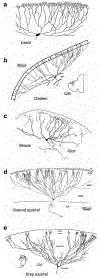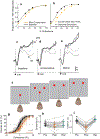Unraveling circuits of visual perception and cognition through the superior colliculus
- PMID: 33548173
- PMCID: PMC7979487
- DOI: 10.1016/j.neuron.2021.01.013
Unraveling circuits of visual perception and cognition through the superior colliculus
Abstract
The superior colliculus is a conserved sensorimotor structure that integrates visual and other sensory information to drive reflexive behaviors. Although the evidence for this is strong and compelling, a number of experiments reveal a role for the superior colliculus in behaviors usually associated with the cerebral cortex, such as attention and decision-making. Indeed, in addition to collicular outputs targeting brainstem regions controlling movements, the superior colliculus also has ascending projections linking it to forebrain structures including the basal ganglia and amygdala, highlighting the fact that the superior colliculus, with its vast inputs and outputs, can influence processing throughout the neuraxis. Today, modern molecular and genetic methods combined with sophisticated behavioral assessments have the potential to make significant breakthroughs in our understanding of the evolution and conservation of neuronal cell types and circuits in the superior colliculus that give rise to simple and complex behaviors.
Keywords: action; adaptation; attention; avoidance; conservation; decision-making; defensive behaviors; escape behaviors; evolution; lamination; motor maps; neural cartography; optic tectum; orienting; prey capture; sensory maps; vision.
Copyright © 2021 Elsevier Inc. All rights reserved.
Figures








References
-
- Abramson BP, and Chalupa LM (1988). Multiple pathways from the superior colliculus to the extrageniculate visual thalamus of the cat. J Comp Neurol 271, 397–418. - PubMed
-
- Aizawa H, Kobayashi Y, Yamamoto M, and Isa T (1999). Injection of nicotine Into the superior colliculus facilitates occurrence of express saccades in monkeys. Journal of Neurophysiology 82, 1642–1646. - PubMed
-
- Albano JE, Norton TT, and Hall WC (1979). Laminar origin of projections from the superficial layers of the superior colliculus in the tree shrew, Tupaia glis. Brain Research 173, 1–11. - PubMed
-
- Appell PP, and Behan M (1990). Sources of subcortical GABAergic projections to the superior colliculus of the cat. The Journal of Comparative Neurology 302, 143–158. - PubMed
-
- Apter JT (1945). Projection of the retina on superior colliculus of cats. J Neurophysiol 8, 123–134.
Publication types
MeSH terms
Grants and funding
LinkOut - more resources
Full Text Sources
Other Literature Sources

